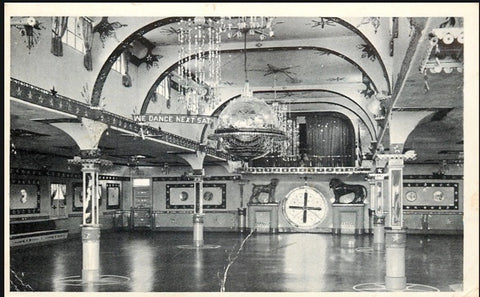Letter 1 - Dance Card

This is a picture of Van’s Dance Hall located on Main Street in Delta, Utah. During WWII, just outside of Delta (population roughly 3,500) in the West Desert, the U.S. Government built the Japanese American Interment camp called Topaz (https://www.youtube.com/watch?v=Yr_fckAJ2_8).
Hannie (the writer and artist behind The Flower Letters) grew up in a little town just east of Delta and so her upbringing was filled with stories, school reports, and fieldtrips surrounding Topaz and the famous dances held at Van’s Dance hall. The dance hall was built by Billy Van De Vanter, which he began in 1927 and improved on until his death in 1942. Van’s Dance hall was so well-loved, with it’s unique art, architecture, and 20,000 mirror pieces, that it was once voted American’s best dance hall.
Because of the significant role it played, a nostalgic residue of the WWII era lingers in Delta and the surrounding county. Hannie grew up attending dances at her hometown that were very much like what one would find during 1943 when Audrey Rose and Charlie meet at the 4th of July Ranger dance. In Oak City, Utah (15 miles East of Delta) there is even a Big Band style ensemble called The Moonlighters that still plays every Saturday before Memorial Day and every third Saturday in August for the little city’s town days. The Moonlighters played songs like “Smoke Gets in your Eyes,” “In the Mood,” “The Rusty Dusty Blues,” “Jeep Jocky Jump,” “Moonlight Serenade,” and “The Bunny Hop” to name a few.
Social dancing during WWII was not only important for keeping up morale among the troops and civilians, but it was the new way of courting among young people. Rather than chaperoned courting visits in family parlors and on porch swings, informal Big Band dances were more acceptable for young people in the 1940s. Dancing became a way of coping with first, the Great War, followed by the Great Depression, and finally the horrors of yet another World War.
The “Swing Era” began around 1935 and lasted until roughly 1945. Big bands such as the Glenn Miller, Tommy Dorsey, Harry James, and Duke Ellington Bands traveled the country to play for eager young dancers the way musical artists travel the country to play concerts for eager fans today.
We’ve complied a playlist of the songs found on the dance card included in the first letter of the Audrey Rose Collection. These are all hits from the year 1943 for you to listen to and get a real sense of what a dance from this time period might’ve been like. We hope you enjoy learning about the Big Band Era!
Also, if you happen to be the more adventurous type, here’s a link to a great “Swing” tutorial, which was the popular dance of the time. This is a six-part series. We recommend the entire series in order to get a good introduction to swing dancing. Have fun becoming a bonafide Jive Bomber!
https://www.youtube.com/watch?v=-FvsnqL124Q&t=7s
https://www.youtube.com/watch?v=YvIrBXnisRE
https://www.youtube.com/watch?v=epuXyK0C_bk
https://www.youtube.com/watch?v=1fgmJcqB0Uw
https://www.youtube.com/watch?v=Rr-PrzCLmZQ

